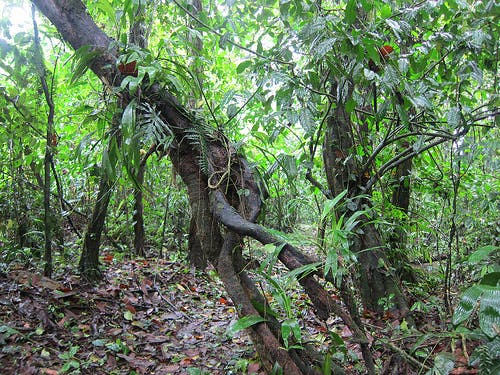Farm Tour Diaries: Costa Rica


Rainforest on the grounds of a Costa Rica flower farm
PHOTOGRAPHY: Anna Clark
It’s pouring rain, and together with farmers and their families and fellow journalists, I’m huddled in a shelter open to wet gusts of wind. In the growing dark, candles are lit and a halved green coconut is handed to me, along with a straw. I sip the fresh, sweet coconut water.
The impromptu celebration ends a visit to a farm in Costa Rica, one of 22 smallholders forming a collective known as Verde Tica, which is beginning the Rainforest Alliance certification process for their passion fruit. Earlier I’d been served passion fruit juice—pulpy and tart-sweet—while listening in on a training session for farmers about using safety gear, including gloves, apron, and face mask, when handling pesticides.
I wasn’t the only journalist on the RA-sponsored junket alarmed to learn that certification allows for chemical pesticides, even select ones. But it’s also true that certification requires a reduction in agrochemical use from year to year, and may be revoked if progress lags behind a certain percentage, as monitored by annual—and occasionally surprise—audits. In the interim, safety practices extend to the community.
During a visit to Empresa de Servicos de San Alberto S.A., an RA-certified banana farm collective, an auditor named Irene Trejos who accompanied our junket pointed out the hibiscus bordering the fields. These tall flowering shrubs are planted as a barrier against the drift of agrochemicals from crops to public roads, streams, and workers’ homes.

Bananas produced at Empresa de Servicos de San Alberto S.A.
PHOTOGRAPHY: Anna Clark
The search for alternatives to agrochemicals is also under way, as we saw at the School for Field Studies Center for Sustainable Development Studies, an orange and mango research farm certified since 2011. Here, staff is testing organic pest control against leaf cutter ants.
SFS Center Director Gerardo Avalos, PhD, talked candidly about the challenge of putting into practice the multiple requirements for certification, from community outreach, in SFS’s case, working with the local government to restore an adjoining river, to composting (we saw plenty of compost piles on our farm visits). Certification, the Rainforest Alliance says, is built on “the three pillars of sustainability”—environmental protection, social equity, and economic viability—which calls for a balancing act rivaling any with Cirque du Soleil. Taking a long-term view helps, noted Dr. Avalos.
Settling for less than momentous change in the face of looming ecological crisis isn’t easy for someone with patience deficit disorder like me. But what’s the alternative? Degradation of the rainforest isn’t waiting for perfect compliance with sustainable practices. With an agricultural conglomerate like Chiquita backing certification for Verde Tica as a supplier of its passion fruit juice, there’s hope that sustainability is moving (OK, inching) closer toward the norm.

Passion fruit on the vine at Verde Tica
PHOTOGRAPHY: Anna Clark
Chiquita’s participation in RA certification is all the more astounding given that the program started in Costa Rica in the 1990s to counter abuses in banana plantations. Whether Chiquita’s motivation to clean up its act owes more to outside scrutiny than inner reflection, the change isn’t simply cosmetic. True, the Rainforest Alliance Certified seal may be granted for only a percentage of ingredients, clearly specified on packaging. But it’s not a static picture—again, a farm lagging behind on progress loses certification. Nor is it an abstract one.
During a visit to Plantas y Flores Ornamentales, a 450-acre certified flower farm in Llano Grande de Cartago, we ventured into the 10 percent of land preserved as rainforest. Under towering trees, treading a path of mud and rocks and sodden leaves, we glimpsed tiny bright red frogs with denim blue legs and sloths nestled on overhanging branches.
Here’s the reality we witnessed, along with the pride of farmers sharing the fruits of their labors with us as storms raged.

For a list of products with ingredients certified by the Rainforest Alliance, visit rainforest-alliance.org/green-living/shopthefrog.